![]()
![]()
![]()
Use LEFT and RIGHT arrow keys to navigate between flashcards;
Use UP and DOWN arrow keys to flip the card;
H to show hint;
A reads text to speech;
44 Cards in this Set
- Front
- Back
- 3rd side (hint)
|
Intervertebral Disk Disease (IVDD)
|
• Chondroid degeneration
o Chondrodystrophoid o Young dogs • Fibroid degeneration o Non-chondrodystrophoid o Old dogs • Extrusion vs Protrusion |
• Narrowed/wedged intervertebral disk space
• Reduced size/ increased opacity of the intervertebral foramen • Narrowed articular process space |
|
|
Spondylosis Deformans
|
• Incidental finding- BORING
- degenerative change of older animals |
• Collar of new bone forming around the intervertebral disk
|
|
|
Cervical Spondylomyelopathy
|
• Compression of spinal cord and/or spinal nerves
• 2 forms: o Doberman • Disk protrusion • Ligamentous hypertrophy • Most common C5-6 or C6-7 o Great Dane, other giant breeds • Articular process enlargement • Joint capsule thickening • Disk herniation • Ligamentous hypertrophy • Throughout cervical vertebral column |
• Narrowed or wedged disk space
• Vertebral malalignment/ subluxation • Vertebral shape change- bone remodeling • Decreased height of vertebral canal • Giant breeds- enlarged articular processes |
|
|
Lumbosacral Disease
|
• Large breed dogs, especially German Shepherds
• IVDD L7-S1 • DJD of articular process joints • Vertebral canal stenosis • Instability • Pain, weakness, urinary and fecal incontinence, paraparesis, tail weakness- compression of cauda equine |
• Narrowed/wedged disk space
• Vertebral malalignment • Decreased height of vertebral canal • Spondylosis deformans • Articular process osteophytosis • Excessive movement on dynamic images |
|
|
Diskospondylitis
|
• Infectious process affecting intervertebral disk and adjacent vertebral endplates
• Hematogenous infections- Staph and E. coli; Brucella canis |
• HALLMARK: endplate lysis
• New bone production • Sclerosis • Disk space narrowing • More than one site • 3-4 weeks to become visible on radiograph |
|
|
Ventral Vertebral Periosteal Reaction
“Spondylitis” |
• Neoplasia- carcinoma metastasis
• Inflammatory- Spirocerca lupi |
• Proliferative new bone on ventral aspect of vertebra- NOT centered on disk space
|
|
|
Atlantoaxial Instability
|
• Miniature breeds
• Show signs before 1 yr old o Neck pain o UMN signs to all limbs o Worse when neck flexed • Causes: o Congenital ligament deficiency o Congenital hypoplasia, agenesis, or non-union of dens o Traumatic injury • Spinous process of C2 should overlap C1 |
• Increased distance between spinous process of C2 and dorsal arch of C1
• Malalignment of C1 and C2 • Absent, misshapen, or separated dens |
|
|
Vertebral Neoplasia
|
• Osteosarcoma
• Multiple myeloma |
• Lytic lesions
|
|
|
Vertebral Trauma
|
• Describe in reference to cranial vertebra
|
• Discontinuous cortices
• Bone fragments • Compression fractures (short vertebrae) • Vertebral canal malalignment • Disk space narrowing/widening • Other evidence of trauma in body |
|
|
Block Vertebrae
|
• Congenital union of two vertebrae
|
• Union of 2 vertebrae
|
|
|
Hemivertebrae
|
• Most common vertebral anomaly in brachycephalic breeds
• Leads to curvature of spine: o Kyphosis- dorsal deviation o Lordosis- ventral deviation o Scoliosis- lateral deviation • Butterfly vertebrae- one classification |
• Abnormally shaped vertebra (small and wedge shaped)
• Curvature of spine • Mid-line defect throughout length of vertebrae in butterfly vertebrae |
|
|
Spina Bifida
|
• Incomplete formation of dorsal lamina
• Often incidental |
• Double spinous process
• Lack of spinous process |
|
|
Transitional Vertebrae
|
• Malformed vertebra assumes characteristics of both adjacent regions
• Typically incidental |
• Extra ribs
• Lack of ribs • Disk space between S1 and S2 |
|
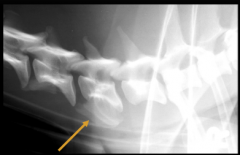
anatomical considerations:
large transverse processes of C6 |
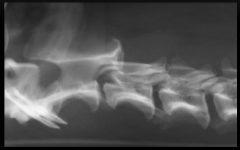
C2-3, C7-T1, T10-T11 normally narrowed disk spaces
|
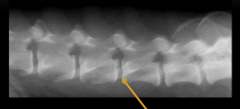
transverse process overlaps the disk space
summation |
|
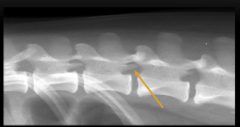
Anatomical Considerations:
|
accessory process overlay the intervertebral foramen
-extend caudally from pedicle |
|
|
|
intervertebral disk extrusion
|
degeneration
complete tear of annulus translation of degenerate nucleus into vertebral canal |

|
|
|
intervertebral disk protrustion
|
degeneration
partial tear of annulus translation of degenerate nucleus into space occupied by annulus |
|
|

|
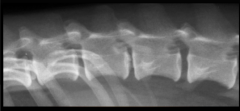
IVDD
narrowed joint space - decreased size of intervertebral foramen, wedged narrowed disk space |
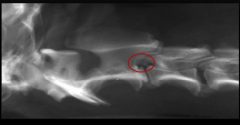
increased opacity of intervertebral foramen
|
|

|

IVDD - narrowed articular process joint space
- wedged intervertebral disk space |
|
|

|
spondylosis deformans
|
|
|
|
Cervical Spondylomyelopathy
|
dorsal
-ligementum flavum hypertrophy -vertebral arch malformation lateral -articular process enlargement -joint capsule thickening ventral -disk herniation -dorsal longitudinal ligament hypertrophy |
|
|
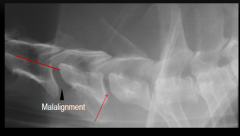
|
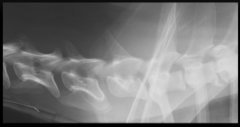
CSM - narrowed disk space
-vertebral malalignment |
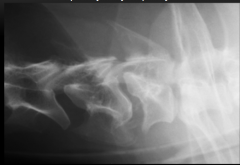
vertebral malalignment
decreased height of canal vertebral shape change |
|

|
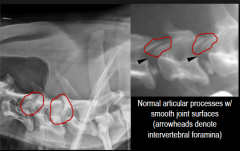
CSM - Great Dane
|

|
|
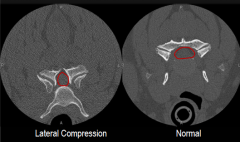
|
csm - great dane
|
|
|
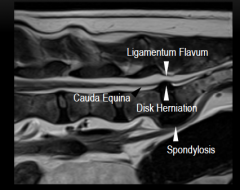
|
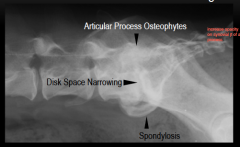
lumbosacral disease
MRI |

|
|

|
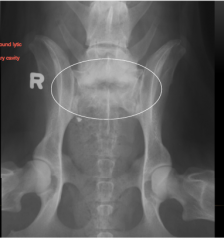
diskospondylitis
|

|
|

|
diskospondyltitis
lytic and sclerotic endplates |
|
|
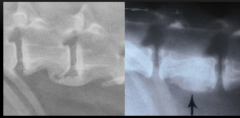
A B
|
A) Spondylosis deformans (centered on disk space - incidental)
B) ventral vertebral periosteal reaction (aggressive lesion, not centered on disk spaces - infection or tumor) |
|
|

|
carcinoma mets to lumbar vertebrae
|
|
|

|
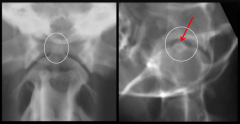
Atlantoaxial joint:
anatomical considerations spinous process of C2 overlap C1 dorsal atlantoaxial ligament * |
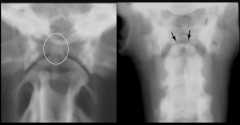
normal dens vs hypoplastic dens
normal dens vs agenesis of dens |
|

|

|
|
|

|
increased distance between spinous process of C2 and dorsal arch of C1
malalignment of C1 and C2 absent,misshapen, seperated dens |

A B
normal atlantoaxial instability |
|

|
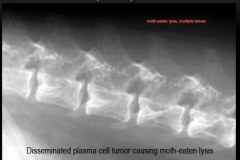
osteosarcoma
|
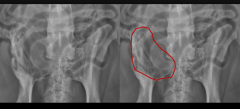
sacral and ilial sarcoma
|
|
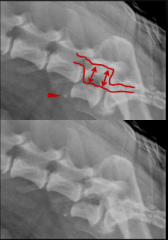
|
L6-7 fracture/luxation
L7 ventrally displaced - disk space obliterated deviated vertebral canal separation of L7 lamina from body small chip fracture |
|
|
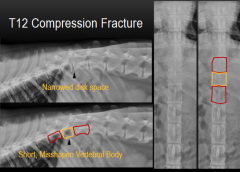
|
t12 compression fracture
|
|
|

|
block vertebrae
absence of disk space congenital or diskospondylitis |
|
|
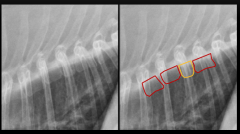
|
hemivertebrae
one is shorter than the others |
|
|
|
kyphosis
|
dorsal deviation of the spine
|
|
|
|
lordosis
|
ventral deviation of the spine
|
|
|
|
scoliosis
|
lateral deviation of the spine
|
|
|

|
kyphosis
|
|
|

|
butterfly vertebrae
midline defect throughout length of vertebrae |
|
|

|
spina bifida
incomplete formation of dorsal lamina common in screw tail dogs and manx cats double spinous process or lack of spinous process often incidental |
|
|
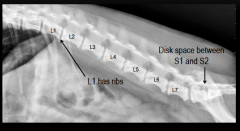
|
2 transitional vertebrae
|
|

